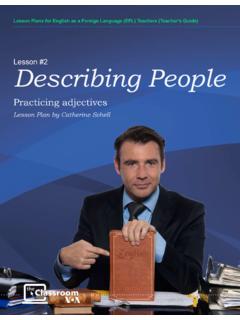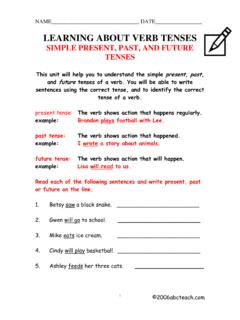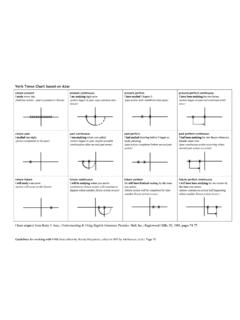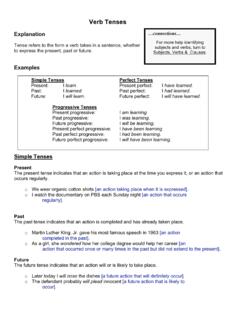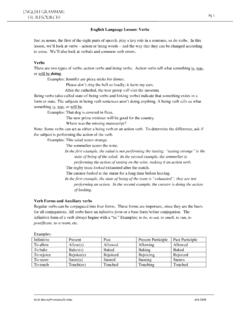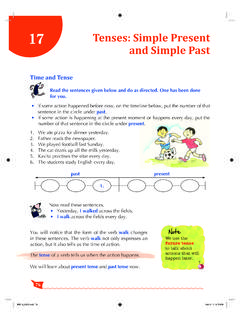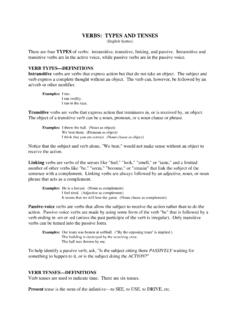Transcription of Lesson #10 Regular verbs: Simple past tense
1 Lesson Plans for English as a Foreign Language (EFL) (Student Edition) Lesson #10 Regular verbs: Simple past tenseLesson Plan by Catherine Schell & Dr. G rard Beck Voice of America s EFL Teaching Community Lesson 10: Page 2 On Facebook: VOA LearningEnglish Learn English with the English Doctor and the English Traveler at Lesson Plans for English as a Foreign Language (EFL) Teachers GuideRegular verbs: Simple past tenseWARM-UP:PASTY esterday Then In 1968, 1991, etc.
2 PRESENTT oday Now In 2011 FUTURET omorrow Then In 2012, etc The goals of this week s Classroom Lesson (#10) are to learn more about the Simple past tense of Regular verbs. In this les-son, you will learn how to recognize and use the Simple past tense of Regular verbs in order to further extend your knowl-edge of verb conjugation in English. You will be able to master this skill through the following text, grammatical explana-tions, and exercises within VOA s The Classroom. Talking about the past :When were you born?
3 I was born in _____ (date)Where were you born? I was born in _____ (city, country)What are the historical events that marked you? Why?Memorable quotes about time: Learn from yesterday, live for today, hope for tomorrow. The important thing is not to stop question-ing. ~ Albert Einstein Life can only be understood backwards, but it must be lived forward. ~ Soren KierkegaardWhat do these quotes mean to you? Lesson Plans for English as a Foreign Language (EFL) Teachers GuideVoice of America s EFL Teaching Community Lesson 10: Page 3 On Facebook: VOA LearningEnglish Learn English with the English Doctor and the English Traveler at Regular verbs: Simple past tenseTEXTSB elow is an edited version of a VOA News article.
4 Read it and underline all the Regular Simple past tenses you can experimented with many new customs and social traditions during the 1920s. There were new danc-es, new kinds of clothes and some of the most imaginative art and writing ever produced in the United States. Many people labeled the period The Roaring Twenties , to show the exuberance and vitality of the artistic and social scenes. But in most ways, the 1920s were a conservative time in American life. Voters elected three conservative Republican presidents: Warren Harding, Calvin Coolidge and Herbert Hoover.
5 And they supported many con-servative social and political policies. Congressman McMillan of Charleston, South Carolina with two women who are doing the Charleston dance near the Capitol building in Washington Most Americans in the 1920s shared some ties through blood or marriage to the first Americans who came from Britain. Many people with these kinds of historic ties considered themselves to be real Americans, true traditionally welcomed newcomers from such western Euro-pean countries as Britain, France, or Germany.
6 But most of the people coming to New York City and other harbors in the 1920s arrived from the central, eastern and southern areas of Europe. Some Americans soon worried about these millions of people arriving at their shores. They wor-ried that the immigrant newcomers might steal their jobs. Or they feared the political beliefs of the immigrants. Pressure to control immigration increased following World War I. Congress passed a bill that set a limit on how many people would be allowed to enter from each foreign country.
7 The nineteen twenties were a time of economic progress for most Americans. During the administrations of President Warren Harding and President Calvin Coolidge, many companies grew larger, creating new jobs. Wages for most Americans increased. Many people began to have enough money to buy new kinds of strong economy also created the right environment for many important changes in the day-to-day social life of Americans. The nineteen twenties are remembered now as an exciting time that historians call the Roaring Twenties.
8 This week in our series, Kay Gallant and Harry Monroe tell more about that period.(MUSIC)Voice of America s EFL Teaching Community Lesson 10: Page 4 On Facebook: VOA LearningEnglish Learn English with the English Doctor and the English Traveler at Lesson Plans for English as a Foreign Language (EFL) Teachers GuideKAY GALLANT: The nineteen twenties brought a feeling of freedom and independence to millions of Ameri-cans, especially young Americans.
9 Young soldiers returned from the world war with new ideas. They had seen a different world in Europe. They had faced death and learned to enjoy the pleasures that each day of these young soldiers were not willing to quietly accept the old traditions of their families and villages when they returned home. Instead, they wanted to try new ways of MONROE: Many young Americans, both men and women, began to challenge some of the traditions of their parents and grandparents. For example, some young women began to experiment with new kinds of clothes.
10 They no longer wore dresses that hid the shape of their bodies. Instead, they wore thinner dresses that uncovered part of their young women began to smoke cigarettes, too. Cigarette production in the United States more than dou-bled in the ten years between nineteen eighteen and nineteen women also began to drink alcohol with men in public for the first time. And they listened together to a popular new kind of music: people danced the Fox Trot, the Charleston, and other new dances. They held one another tightly on the dance floor, instead of dancing far apart.
